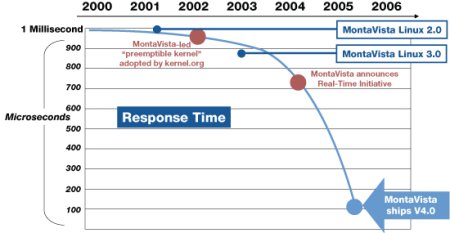MontaVista touts native hard real-time Linux
Aug 2, 2005 — by LinuxDevices Staff — from the LinuxDevices Archive — 1 viewsMontaVista says the open source real-time Linux project that it founded has produced a full-fledged real-time kernel suitable for time-critical embedded applications on mobile handsets and telecommunications equipment. The Open Source Real-time Linux Project's patch yields 30 times better responsiveness than the current stock Linux kernel, the company claims.
MontaVista founded the Open Source Real-time Linux Project in October of last year, seeding the project with a prototype kernel that implemented a resource locking system based on mutexes (mutual exclusion objects). The mutexes aimed to reduce the number of “critical sections” in Linux kernel code — places where processes accessing shared resources such as memory data cannot be pre-empted, even by higher priority tasks.
According to MontaVista, a stock Linux kernel contains about 10,000 critical sections in six million lines of code, and that optimizing all 10,000 sections to execute within defined time boundaries would have been virtually impossible. The mutex locking system, in contrast, was implemented in less than a year, with help from the open source community, and resulted in a real-time Linux kernel with fewer than 100 critical sections, the company claims. MontaVista subsequently ported the community-developed x86 mutex patch to ARM, MIPS, and PowerPC. It also “further enhanced” the community work, it says.
MontaVista reports that results from the fast real-time domain (FRD) benchmark have “proved MontaVista Linux has 30 times better overall real-time performance” than a standard 2.6.12.3 kernel, and 100 times better than a stock 2.6.10 kernel. Little information about FRD benchmarks is available, other than a post to the LKML (Linux kernel mailing list) by Sven-Thorsten Dietrich, the same MontaVista engineer who originally announced the real-time project in an LKML post last October.

MontaVista's timeline of native real-time Linux performance
MontaVista says applications developed on proprietary, real-time operating systems (RTOSes) can be migrated easily to its new real-time Linux kernel, which will become a standard feature in forthcoming MontaVista products. MontaVista expects its real-time technology to have the biggest immediate impact on mobile phone manufacturers and network equipment providers, which it says are increasingly pressured to deliver features that outstrip the capabilities of aging RTOSes. The company calls Linux a “strategic end-to-end platform” for next-generation communications infrastructure and mobile and wireless devices.
Cypress Semiconductor earlier announced it would port its routing table management software to a real-time version of MontaVista Linux. MontaVista competitor FSMLabs, which has long marketed a relatively mature dual-kernel (non-native) real-time version of Linux, shipped a real-time Carrier Grade Linux product this spring.
For more about MontaVista's evolving focus on both ends of the virtual wire, be sure to read our story about the launch of Mobilinux, its Linux OS targeting smartphones and the high-volume single chipset featurephone market.
Kevin Morgan, VP of engineering at MontaVista, said, “Benchmarks clearly demonstrate that Linux now has real-time interrupt response times that previously could only be achieved by proprietary RTOS products.”
This article was originally published on LinuxDevices.com and has been donated to the open source community by QuinStreet Inc. Please visit LinuxToday.com for up-to-date news and articles about Linux and open source.